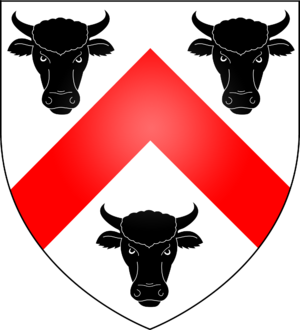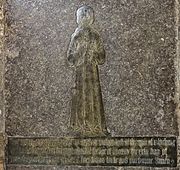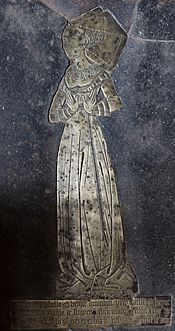Geoffrey Boleyn facts for kids
Quick facts for kids
Geoffrey Boleyn
|
|
|---|---|

The Boleyn family crest, showing three bull's heads.
|
|
| Lord Mayor of London | |
| In office 1457–1458 |
|
| Sheriff of London | |
| In office 1446–1447 |
|
| Personal details | |
| Born | 1406 |
| Died | 1463 |
| Occupation | Merchant |

Sir Geoffrey Boleyn (born 1406, died 1463) was an important English businessman and politician. He served as the Lord Mayor of London from 1457 to 1458.
He bought two famous properties: the manor of Blickling in Norfolk in 1452, and Hever Castle in Kent in 1462. Sir Geoffrey is also famous because he was the great-grandfather of Queen Anne Boleyn. Anne Boleyn was the second wife of King Henry VIII and the mother of Queen Elizabeth I.
Sir Geoffrey helped the Boleyn family become very wealthy and respected. He built up their business and their standing in society. His brother, Thomas Boleyn, also had a successful career in the church and at university. Together, they greatly increased their family's wealth, influence, and reputation.
Contents
Sir Geoffrey's Family
Geoffrey Boleyn's father was also named Geoffrey Boleyn (who died in 1440). His father was a yeoman (a farmer who owned his land) from Salle in Norfolk. Geoffrey's mother was Alice Bracton.
A special monumental brass in Salle Church remembers Geoffrey and Alice Boleyn. It shows them standing side by side with a prayer. This brass also mentions their children. Sir Geoffrey Boleyn had four brothers and four sisters.
Notable Family Members
- Thomas Boleyn (died 1472) was a priest and a very important person. He was the Master of Gonville Hall, Cambridge. He also helped manage his brother Geoffrey's will after he died.
- Cecily Boleyn (1408–1458) was Geoffrey's sister. She died at the age of 50 and never married. Her own special brass can be seen at Blickling.
Sir Geoffrey's Career
Geoffrey Boleyn moved to the City of London to start his career. He first trained as a hatter (someone who makes hats). In 1428, he became a "freeman of the City" through the Company of Hatters. This meant he could work and trade freely in London.
However, he soon became more interested in selling fine fabrics, a trade known as "Mercery." In 1435, he joined the Worshipful Company of Mercers, which was a very important and wealthy guild.
Important Roles in London
- Sheriff of London (1446–1447): He helped keep law and order in the city.
- Member of Parliament (February 1449): He represented the City of London in the English Parliament.
- Alderman (1452–1463): He was a senior member of the city council.
- Master of the Mercers' Company (1454): He led the powerful Mercers' guild.
Lord Mayor of London
In 1457, Sir Geoffrey Boleyn became the Lord Mayor of London. He was knighted by King Henry VI. During his time as Mayor, there was a lot of tension between two powerful groups, the Yorkists and the Lancastrians. Sir Geoffrey gathered a strong group of citizens to make sure peace was kept in the city.
Land Purchases
Sir Geoffrey bought the manor of Blickling in Norfolk in 1452. Later, in 1462, he bought Hever Castle in Kent. These purchases showed how successful and wealthy he had become. Buying these large estates was a way for him to gain higher social status.
Death and Burial
Sir Geoffrey Boleyn died in 1463. He was buried in the Church of St Lawrence Jewry in the City of London. In his will, he left money to improve the church and a large sum to each of his three unmarried daughters.
Marriage and Children
Sir Geoffrey Boleyn was married twice. His first wife was named Dionisia. His second wife was Anne Hoo (1424–1484). Anne was the only child of Thomas Hoo, Baron Hoo and Hastings, a famous knight.
With Anne Hoo, Sir Geoffrey had two sons and three daughters:
- Thomas Boleyn (died 1471): His eldest son.
- Sir William Boleyn (1451–1505): He was also a member of the Mercers' Company. William married Margaret Butler. Their son was Thomas Boleyn, 1st Earl of Wiltshire, who became the father of Queen Anne Boleyn. This means Sir William was Queen Anne Boleyn's grandfather.
- Isabel Boleyn (died 1485): She married William Cheyney. Her memorial brass can still be seen in Blickling Church.
- Alice Boleyn (died around 1480): She married Sir John Fortescue.
- Anne Boleyn (died around 1509): She married Sir Henry Heydon.
Boleyn Family Crest
The original Boleyn family crest shows three black bull's heads on a silver shield. Sir Geoffrey Boleyn also used a special design that combined his family crest with his mother's family crest (the Bracton family).



